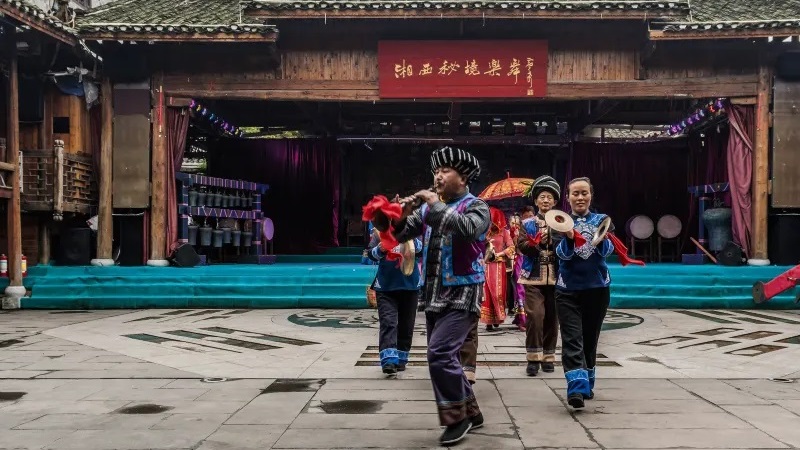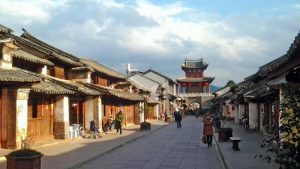The Chinese use the word “翻新” (fanxin). Individually, the character “翻 ” means “to turn upside down” and “新” means new. The two characters together mean “to revamp”, “to make over”. Many ancient towns and villages have had a major make over in China. Usually, the make-over or fanxin process consists in tearing down the old structure and rebuilding it anew.
In an earlier Walrus PHP post, I wrote about Longli (龙里), an ancient Ming era garrison in eastern Guizhou (贵州) that was being given a major face-lift when I visited. Also, in the remote village of Lushi (鲁史) on the old Tea and Horse Road (茶马古道) in Yunnan (云南) province, I told about an 300-year old Ming dynasty temple that had been taken down and completely re-built.
Make-over and Embellishment
As foreigners visiting this country, we are quick to lament over the loss of traditions and to worry about the way China is preserving its cultural and historical heritage. When an old town or an ancient temple go through a make-over process or”翻新” (fanxin), nothing from the former historical structure remains.
In Longli and Lushi, locals and workers do not see the fanxin as a loss or destruction. This make-over process, which consists in the total destruction of the original building and its reconstruction, is seen by locals as an embellishment. In most cases, this “embellishment” process is a step towards an opening to mass-tourism, commercialisation and commodification of the place. In the case of Longli, a town I visited during the fanxin process, I was told that an entrance fee will be charged once work is completed. In Qianzhou (乾州), the entire town was levelled to the ground and rebuilt anew. Of course, visitors are charged an 80 RMB entrance fee.
The Case of Qianzhou
Nothing remains of the original Qianzhou (乾州). Located south of Jishou (吉首) in western Hunan province (湘西), Qianzhou used to be an military outpost and command centre in an ethnic region where the Miao people had to be tamed and integrated into the empire. Founded during the Song dynasty in 1070, walls were built during the middle of the Ming dynasty in 1514. By the Qing dynasty it was a small stone fortress where Confucianism prevailed.
Qianzhou was implanted near the territory of the Miao where, since the Yuan dynasty a system of indirect rule known as tusi had been implemented. Local Miao rulers could govern their own people. Everything changed during the Qing dynasty when the emperor decided to abandoned the system of local rulers and replace it by Han government officials appointed by the imperial court.
I did not know exactly what to expect when I set my mind to visit Qianzhou. At that time, I had seen Qianyang (黔阳) an intact and well-preserved ancient town that has not yet succumbed to the commercialisation and ‘Disneylandification Online Poker‘ that I saw in Fenghuang (凤凰). Yet, I did not expect to have the witness of an important part of China’s military history like Qianzhou to have been physically erased and replaced by shiny new town, too new to be look old.
Yes, the streets lined with newly built structures home to dozens of trinket stores and local delicacies were re-built at the same spot as the Qianzhou that started 1000 year ago during the Song and flourished as a military centre during the Ming and Qing dynasties, but my brain could not accept that the barely 10-year old walls, houses and watchtowers had any sort of historical value.
This “ancient” town has no soul. To me, Qianzhou was as fake as NorthFace backpack bought at the Silk Market in Beijing …
Different Views
While heading south of Guangzhou to visit the Kaiping watchtowers (开平碉楼), a Chinese friend worried they had gone through a fanxin-like renovation process. I said that it was not possible because part of them are protected by UNESCO and listed as world cultural heritage. She raised an eye-brow.
In China, the fanxin-like renovation process does not bother everyone. Somehow, the entire destruction and re-construction of a 500-year old town can be inscribed in the process of history. In 200 years people will say that Qianzhou was renovated at the beginning of the 21st century. After all it was expanded and renovated during the Ming and Qing dynasties.
If the new Qianzhou is still at the same geographical location of the ancient Qianzhou, to www.edwardlifson.com, it has lost its historical value, soul and interest. A lot of villages in the region look exactly like Qianzhou … and they are free.
What if the cathedral of Notre-Dame of Paris finished during the 14th century was torn down and re-built anew with contemporary materials?



